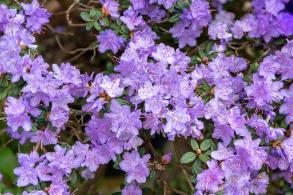Dwarf Rhododendron Blue Diamond
1. Add items to basket
2. Go to the basket
3. Enter your postcode in Delivery Price Check
Pot size: 20 Litres
Plant ID: 10268 114
Dwarf Rhododendron Blue Diamond
Rhododendron Blue Diamond is an evergreen rhododendron that belongs to the family of Dwarf Lepidote Hybrids which owe their name to the scale-like texture of the undersurface of the foliage. Low-growing and highly decorative, this semi-dwarf evergreen to semi-evergreen azalea-like shrub produces masses of violet-blue small flowers in clusters between April and May. The shades of blue tend to vary (adding to their charm) and are borne up to 5 in a truss. The evergreen foliage consists of elliptic, azalea-like leaves which start out medium green and turn to a bronze-greenish in the autumn.
A UK native, this dwarf rhododendron was hybridized in 1935, by J. J. Crosfield of Embley Park, England.
Height and Spread of Dwarf Rhododendron Blue Diamond
A semi-dwarf cultivar, Blue Diamond Rhododendron will achieve a maximum size of 1.5 metres in height and width.
How Hardy is Dwarf Rhododendron Blue Diamond
Blue Diamond Rhododendron is a tough, resilient evergreen shrub and it is fully hardy in the United Kingdom and will tolerate temperatures as low as -5 degrees Celsius.
How To Use Dwarf Rhododendron Blue Diamond
Alpine in origin, this semi-dwarf evergreen shrub is a great choice for rock gardens where it can add a much-needed touch of bright colour. Similarly, due to its compact size, Blue Diamond Rhododendron thrives in raised beds or small gardens. Plant on its own or in mass plantings, either way, the beautiful violet blooms will captivate. In colder weather this shrub can lose some foliage outdoors but refoliates again by early Summer.
How To Care For Dwarf Rhododendron Blue Diamond
Undemanding and adaptable, Blue Diamond Rhododendron does not need much to thrive in your garden. Unlike other rhododendron varieties that do well in shade, owing to its origin, this alpine shrub will do best in full sun so pick a sunny spot in the garden. However, a trait that Blue Diamond shares with other rhododendrons is that it requires well-drained, acidic soil to grow in. For best results, enrich the soil with ericaceous feed if you are unsure about the pH value or want to enhance the acidity.











